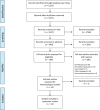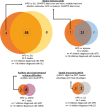Same or Different: The Overlap Between Children With Auditory Processing Disorders and Children With Other Developmental Disorders: A Systematic Review
- PMID: 28863035
- PMCID: PMC7654752
- DOI: 10.1097/AUD.0000000000000479
Same or Different: The Overlap Between Children With Auditory Processing Disorders and Children With Other Developmental Disorders: A Systematic Review
Abstract
Objectives: Children diagnosed with auditory processing disorders (APD) experience difficulties in auditory functioning and with memory, attention, language, and reading tasks. However, it is not clear whether the behavioral characteristics of these children are distinctive from the behavioral characteristics of children diagnosed with a different developmental disorder, such as specific language impairment (SLI), dyslexia, attention-deficit hyperactivity disorder (ADHD), learning disorder (LD), or autism spectrum disorder. This study describes the performance of children diagnosed with APD, SLI, dyslexia, ADHD, and LD to different outcome measurements. The aim of this study was to determine (1) which characteristics of APD overlap with the characteristics of children with SLI, dyslexia, ADHD, LD, or autism spectrum disorder; and (2) if there are characteristics that distinguish children diagnosed with APD from children diagnosed with other developmental disorders.
Design: A systematic review. Six electronic databases (Pubmed, CINAHL, Eric, PsychINFO, Communication & Mass Media Complete, and EMBASE) were searched to find peer-reviewed studies from 1954 to May 2015. The authors included studies reporting behaviors and performance of children with (suspected) APD and children diagnosed with a different developmental disorder (SLI, Dyslexia, ADHD, and LD). Two researchers identified and screened the studies independently. Methodological quality of the included studies was assessed with the American Speech-Language-Hearing Association's levels-of-evidence scheme.
Results: In total, 13 studies of which the methodological quality was moderate were included in this systematic review. In five studies, the performance of children diagnosed with APD was compared with the performance of children diagnosed with SLI: in two with children diagnosed with dyslexia, one with children diagnosed with ADHD, and in another one with children diagnosed with LD. Ten of the studies included children who met the criteria for more than one diagnosis. In four studies, there was a comparison made between the performances of children with comorbid disorders. There were no studies found in which the performance of children diagnosed with APD was compared with the performance of children diagnosed with autism spectrum disorder. Children diagnosed with APD broadly share the same characteristics as children diagnosed with other developmental disorders, with only minor differences between them. Differences were determined with the auditory and visual Duration Pattern Test, the Children's Auditory Processing Performance Scale questionnaire, and the subtests of the Listening in Spatialized Noise-Sentences test, in which noise is spatially separated from target sentences. However, these differences are not consistent between studies and are not found in comparison to all groups of children with other developmental disorders.
Conclusions: Children diagnosed with APD perform equally to children diagnosed with SLI, dyslexia, ADHD, and LD on tests of intelligence, memory or attention, and language tests. Only small differences between groups were found for sensory and perceptual functioning tasks (auditory and visual). In addition, children diagnosed with dyslexia performed poorer in reading tasks compared with children diagnosed with APD. The result is possibly confounded by poor quality of the research studies and the low quality of the used outcome measures. More research with higher scientific rigor is required to better understand the differences and similarities in children with various neurodevelopmental disorders.
Conflict of interest statement
The authors declare no conflict of interest.
Figures


Similar articles
-
Temporal auditory and visual motion processing of children diagnosed with auditory processing disorder and dyslexia.Ear Hear. 2009 Dec;30(6):675-86. doi: 10.1097/AUD.0b013e3181b34cc5. Ear Hear. 2009. PMID: 19672194
-
The listening in spatialized noise-sentences test (LISN-S): comparison to the prototype LISN and results from children with either a suspected (central) auditory processing disorder or a confirmed language disorder.J Am Acad Audiol. 2008 May;19(5):377-91. doi: 10.3766/jaaa.19.5.2. J Am Acad Audiol. 2008. PMID: 19253811
-
Validity of the Multiple Auditory Processing Assessment-2: A Test of Auditory Processing Disorder.Lang Speech Hear Serv Sch. 2020 Oct 2;51(4):993-1006. doi: 10.1044/2020_LSHSS-20-00001. Epub 2020 Aug 24. Lang Speech Hear Serv Sch. 2020. PMID: 32831000
-
Childhood auditory processing disorder as a developmental disorder: the case for a multi-professional approach to diagnosis and management.Int J Audiol. 2010 Feb;49(2):83-7. doi: 10.3109/14992020903289808. Int J Audiol. 2010. PMID: 20151881 Review.
-
[Guideline: Auditory Processing and Perception Disorders: Differential Diagnosis : S1 guideline of the German Society of Phoniatrics and Pediatric Audiology].HNO. 2019 Aug;67(8):576-583. doi: 10.1007/s00106-019-0645-3. HNO. 2019. PMID: 30976818 Review. German.
Cited by
-
Traits of Developmental Disorders in Adults With Listening Difficulties Without Diagnosis of Autism Spectrum Disorder And/or Attention-Deficit/Hyperactivity Disorder.J Clin Med. 2024 Oct 21;13(20):6281. doi: 10.3390/jcm13206281. J Clin Med. 2024. PMID: 39458230 Free PMC article.
-
From vision to cognition: potential contributions of cerebral visual impairment to neurodevelopmental disorders.J Neural Transm (Vienna). 2023 Mar;130(3):409-424. doi: 10.1007/s00702-022-02572-8. Epub 2022 Dec 22. J Neural Transm (Vienna). 2023. PMID: 36547695 Review.
-
Speech Perception in Noise Predicts Oral Narrative Comprehension in Children With Developmental Language Disorder.Front Psychol. 2021 Oct 21;12:735026. doi: 10.3389/fpsyg.2021.735026. eCollection 2021. Front Psychol. 2021. PMID: 34744907 Free PMC article.
-
Editorial: Auditory Processing Disorder.Ear Hear. 2018 Jul/Aug;39(4):617-620. doi: 10.1097/AUD.0000000000000582. Ear Hear. 2018. PMID: 29664753 Free PMC article. No abstract available.
-
Recurrent otitis media and behaviour problems in middle childhood: A longitudinal cohort study.J Paediatr Child Health. 2024 Jan;60(1):12-17. doi: 10.1111/jpc.16518. Epub 2023 Nov 14. J Paediatr Child Health. 2024. PMID: 37961922 Free PMC article.
References
-
- [References marked with an asterisk (*) indicate studies included in the systematic review.]
-
- Ahmmed A. U., Ahmmed A. A. Setting appropriate pass or fail cut-off criteria for tests to reflect real life listening difficulties in children with suspected auditory processing disorder. Int J Pediatr Otorhinolaryngol, 2016). 84, 166–173.. - PubMed
-
- American Academy of Audiology. (Clinical practice guidelines. Diagnosis, treatment and management of children and adults with central auditory processing disorders. 2010). Retrieved from http://audiology-web.s3.amazonaws.com/migrated/CAPD%20Guidelines%208-201...
-
- American Psychiatric Association. (Diagnostic and Statistical Manual of Mental Disorders (DSM-III) (1980). 3rd ed). Washington, DC: American Psychiatric Association.
-
- American Psychiatric Association. (Diagnostic and Statistical Manual of Mental Disorders (DSM-IV) (1999). 4th ed). Washington, DC: American Psychiatric Association.
Publication types
MeSH terms
LinkOut - more resources
Full Text Sources
Other Literature Sources
Medical
Research Materials
Miscellaneous

